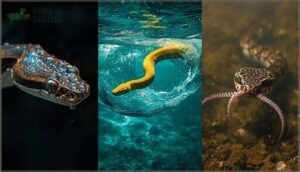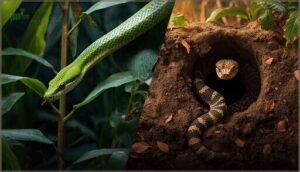This site is supported by our readers. We may earn a commission, at no cost to you, if you purchase through links.

When a sunbeam catches a rainbow boa’s scales at just the right angle, the snake transforms into a living prism—microscopic ridges on each scale splitting light into shimmering waves of color. This optical illusion isn’t vanity; it’s survival machinery perfected over millions of years.
Across 3,800 snake species, evolution has crafted bodies that defy vertebrate conventions: limbless hunters with 400 flexible vertebrae, sea serpents with paddle-shaped tails, and desert dwellers that shimmy sideways across scorching sand. From the hollow fangs that inject paralytic cocktails to the heat-sensing pits that map warm-blooded prey in total darkness, unique snake species characteristics reveal nature’s most radical experiments in vertebrate design.
You’ll discover how these legless predators conquered every habitat—from tropical canopies to ocean depths—through adaptations that rewrote the rules of what a body can do.
Table Of Contents
Key Takeaways
- Snakes’ physical adaptations—from iridescent scales created by microscopic ridges to specialized heat-sensing pits and elongated bodies with up to 400 vertebrae—represent radical evolutionary experiments that enable survival across every habitat from tropical canopies to ocean depths.
- Hunting strategies vary dramatically by lifestyle, with arboreal species developing slender bodies and elongated tails for tree climbing, aquatic snakes evolving paddle-shaped tails and dorsally positioned eyes, and many species switching between diurnal and nocturnal hunting based on temperature and prey availability.
- Venomous snakes employ specialized delivery mechanisms ranging from hollow fangs that inject large quantities (over 130 mg in spectacled cobras) to grooved teeth for slower injection, while non-venomous species rely on theatrical defensive behaviors like thanatosis, mimicry, and chemical deterrents to survive.
- Habitat destruction and fragmentation have triggered catastrophic population declines—including an 81.2% drop in female snakes over one decade—pushing over 250 species toward endangered status and threatening to erase evolutionary adaptations that could inspire breakthroughs in robotics, medicine, and materials science.
Distinctive Physical Traits of Unique Snakes
When you break free from the idea that all snakes look the same, you’ll discover some truly mind-bending adaptations. From shimmering scales that catch light like precious gems to body parts you wouldn’t expect on a serpent, these physical traits aren’t just for show—they’re survival tools honed over millions of years.
Let’s explore the standout features that make certain snake species impossible to forget.
Iridescent and Colorful Scales
You’ll find iridescence in snakes isn’t just eye candy—it’s an evolutionary marvel rooted in scale nanostructures. Brazilian Rainbow Boas showcase these rainbow colors brilliantly, their iridescent skin reflecting light through microscopic ridges that create optical properties worth studying. These colorful ones signal potential mates while staying dirt-free.
Iridescence in snakes isn’t just beautiful—it’s an evolutionary marvel driven by scale nanostructures that serve survival, not mere decoration
Despite iridescence evolution showing 18 times more losses than gains, this unique snake characteristic demonstrates nature’s daring experimentation with colorful signaling mechanisms.
The discovery of new species like the Waray dwarf burrowing snake highlights the importance of iridescent snake research in understanding these adaptations.
Unusual Body Shapes and Appendages
Beyond color, you’ll encounter body designs that break every reptile rule you thought you knew. Some primitive lineages like pythons retain vestigial limbs—those hindlimb spurs trace back 70 million years of evolutionary tinkering.
Consider these radical adaptations:
- Elongated bodies with 200–400 vertebrae enable serpentine freedom
- Paddle tails propel sea snakes through aquatic realms
- Tentacled snake appendages confuse prey in murky waters
Nature’s rebel architects, unbound by convention. Snakes exhibit striking snake physical traits that aid in their survival.
Specialized Scale Morphology
You’ll discover that scale morphology reveals microscopic features as groundbreaking as any snake characteristic. Those tiny spinules and pits on Xenodontinae scales aren’t random—they’re molecular adaptations serving specific functions. River specialists like Hydrops pastazae possess notably larger sensory structures for detecting prey vibrations.
Scale variability between species reflects habitat demands: arboreal snakes develop keeled scales for climbing, while fossorial types showcase friction-reducing patterns essential for underground rebellion against surface life.
Unique Head and Tail Adaptations
Head shape variations tell the story of where snakes thrive—arboreal species sport slender profiles for weaving through branches, while aquatic adaptations feature aerodynamic skulls with dorsally positioned eyes. You’ll notice fossorial types pack compact, wide heads built for underground rebellion.
Tail defense mechanisms range from shield-tailed snakes’ protective osteoderms to longer caudal morphology in males, proving these unique snake characteristics serve survival’s uncompromising demands.
Specialized Hunting and Feeding Strategies
Snakes have evolved impressive methods to catch their prey, from deceptive disguises to specialized body structures that match their environments. Their hunting strategies reflect their unique lifestyles—whether they’re ambushing from treetops, striking in murky waters, or waiting motionless under cover of darkness.
Let’s explore how these adaptations give different species their hunting edge.
Camouflage and Mimicry Techniques
Snakes have mastered the art of disappearing in plain sight, using Pattern Disruption and Visual Deception to outwit predators. Striped patterns make detection up to 40% harder during movement, while mimicry techniques—like milk snakes imitating coral snakes—slash attacks by 90%. Your understanding of these Camouflage Techniques reveals nature’s cunning:
- Spotted patterns near cover reduce predation rates by 35%
- Banded sea snakes receive 15 times fewer attacks than uniform-colored individuals
- Intricate leaf-like patterns cut detection rates by 80% in forests
Arboreal and Aquatic Hunting Adaptations
You’ll notice arboreal snakes have evolved slender bodies and elongated tails—perfect for tree climbing and balance on narrow branches. Their iliocostalis muscles are longer, enabling precise cantilevering between perches where arboreal prey congregates.
Meanwhile, aquatic snakes pack heavier, shorter muscles for powerful swimming strokes during aquatic foraging.
These hunting strategies reveal how snake adaptations and camouflage techniques perfectly match their hunting grounds, whether maneuvering treetops or pursuing fish underwater.
Nocturnal and Diurnal Predation Habits
When temperatures rise, many snakes flip their hunting strategies entirely—embracing nocturnal hunting habits to avoid midday heat. You’ll find predation patterns shift dramatically based on time and temperature, revealing how temporal adaptations shape survival:
- Ball pythons sleep 20-23 hours daily, hunting only at night
- Texas rat snakes switch from diurnal foraging to nocturnal hunting mid-summer
- Aquatic snakes prefer nighttime predator activity due to stable water temperatures
- Prairie rattlesnakes reduce hunting during bright moonlight
These nocturnal snakes demonstrate exceptional snake behavior flexibility in their hunting strategies.
Diet Specialization Among Species
When prey shapes evolution, you’ll witness nature’s most extreme dietary adaptations in action. Some snake species have carved out incredibly narrow ecological niches—queen snakes feast almost exclusively on freshly molted crayfish, while Dipsas specialists extract gastropods with jaw modifications that resemble biological lockpicks.
These crustacean diets and mollusk eaters demonstrate how prey specialization drives unique snake characteristics, even influencing gut microbiota composition and morphological changes essential for survival.
Venomous Versus Non-Venomous Snake Features
When you’re trying to tell venomous snakes from their harmless cousins, the difference isn’t always obvious at first glance. Some venomous species flash bold colors as a warning sign, while others rely on stealth and surprise.
Let’s break down the key features that separate these two groups and the clever ways they’ve adapted to survive.
Venom Delivery Mechanisms
You’ll find venom delivery mechanisms are nature’s most specialized weapons—front-fanged vipers and elapids wield hollow, tubular venom fangs like hypodermic needles, while rear-fanged species rely on grooved teeth for slower injection.
Snake bites vary dramatically in venom yield; spectacled cobras deliver over 130 mg per strike, whereas saw-scaled vipers inject barely 3 mg, showcasing how venomous snake species balance quantity against potency.
Warning Coloration and Defensive Behaviors
Warning coloration and defensive behaviors are your essential playbooks for predator avoidance—nature’s rebellion against becoming someone’s lunch. Aposematic signals like vibrant bands, triangular head shapes, and rattling sounds evolved to scream “danger” before a snake ever strikes.
Here’s how snakes weaponize warning displays:
- Color polymorphism maintains stable frequencies—melanic sea snakes risk higher predation but gain detoxification advantages through enhanced skin sloughing
- Defensive postures exploit predator biases—head flattening and body triangulation trigger learned aversion in birds and mammals
- Sequential defense mechanisms escalate strategically—67% of rattlesnakes rattle or escape before biting, conserving venom for genuine threats
Unique Non-Venomous Defense Strategies
When venomous fangs aren’t your toolkit, you master theatrics instead. Non-venomous snakes deploy thanatosis behavior—flipping belly-up with gaping mouths—or leverage bluffing displays like hissing and neck-flattening to mimic cobras.
Chemical defenses through foul cloacal secretions deter 80% of mammalian predators, while camouflage tactics and mimicry strategies let harmless species impersonate deadly relatives.
These adaptations for survival prove snake defense mechanisms are brilliantly diverse.
Rare and Endangered Snake Species
Some snakes are walking a tightrope toward extinction, clinging to survival in shrinking pockets of the world. Isolation and habitat destruction have pushed certain species to the brink, making them treasures we can’t afford to lose.
Let’s look at how these rare serpents adapted to their unique circumstances and what threatens their existence today.
Island and Isolated Population Adaptations
Island ecosystems forge evolutionary mavericks through Geographical Isolation and Speciation. When snakes colonize remote islands, Founder Effects and Genetic Drift accelerate rapid transformation. You’ll find Species Isolation triggering Adaptive Radiation—small founding populations exploding into diverse forms.
Consider these island-driven changes:
- Body size shifts up to 50-fold compared to mainland relatives
- Venom complexity evolving rapidly with diet specialization
- Unique skull shapes matching novel prey types
- Population densities reaching 76 individuals per square kilometer
- The Santa Catalina Island Rattlesnake losing its rattle entirely
Marine and Island Ecosystems catalyze breathtaking divergence through Ecological Isolation.
Habitat Loss and Conservation Challenges
Adaptive brilliance means nothing when bulldozers arrive. Habitat fragmentation and agricultural expansion have triggered an 81.2% decline in female snake populations over just a decade. You’re watching wildlife conservation race against species decline, but here’s the reality:
| Threat | Impact |
|---|---|
| Agricultural conversion | Forest destruction, prey loss |
| Urban sprawl | Population isolation, genetic bottlenecks |
| Pollution | Contaminated food sources |
| Infrastructure | Migration barriers, local extinctions |
Over 250 unique snake species now face endangered species status. Conservation efforts secured 42 eastern indigo snake releases recently, yet biodiversity loss accelerates faster than funding arrives. Habitat loss fractures ecosystem stability—and ecological balance teeters.
Noteworthy Examples of Rare Species
When threats escalate to extinction’s edge, you’ll find exceptional survivors clinging to existence. These rare snake species demonstrate outstanding resilience against overwhelming odds:
- Saint Lucia Racer — Fewer than 20 individuals survive on a Caribbean islet, making this non-venomous ground snake the world’s rarest.
- Antiguan Racer — Once believed extinct, species rediscovery led to conservation status improvements with roughly 1,000 individuals now.
- Louisiana Pinesnake — Endangered habitats retain only 3% of original longleaf pine forests, restricting populations to fragmented Texas and Louisiana regions.
- Aruban Island Rattlesnake — Island isolates under 230 individuals face tourism development pressures.
These unique snake species showcase unique evolutionary adaptations worth protecting.
Unique Ecological Roles and Adaptations
Snakes have evolved to master nearly every habitat on Earth, from treetops to ocean depths to underground burrows. Each lifestyle demands unique adaptations that push the boundaries of what these reptiles can do—think gliding through air, sensing heat in total darkness, or giving birth to live young in the most unexpected ways.
Here’s how different snake species have carved out their ecological niches and thrived against the odds.
Arboreal, Aquatic, and Burrowing Lifestyles
You’ll find snakes have mastered three distinct lifestyles through exceptional habitat diversity. Arboreal adaptation gives tree-dwelling species like Green Tree Pythons slender bodies and prehensile tails for maneuvering canopies. Water adaptation reshapes aquatic snakes with dorsally positioned eyes and paddle-shaped tails. Burrowing behavior transforms subterranean hunters through reinforced skulls and specialized locomotion.
This burrow ecology demonstrates how snake migration patterns and reptile diversity reflect evolutionary responses to contrasting snake habitats and distribution across vertical, aquatic, and underground realms.
Thermoregulation and Sensory Systems
You’ll discover snakes excel at thermal regulation through three-phase daily cycles—morning rise, midday plateau, afternoon drop—while pit vipers and pythons use heat sensing organs to detect prey from a meter away.
Visual adaptations like rod-dominated eyes support nocturnal hunting, and forked tongues sample chemical signals for tracking.
This sensory evolution showcases exceptional thermoregulation strategies and camouflage mastery across diverse snake adaptations.
Reproductive and Survival Adaptations
You’ll notice viviparity evolution has emerged independently over 100 times in snakes, particularly among vipers occupying cold climates where maternal control of embryonic temperature boosts offspring survival.
Reproductive cycles sync with environmental cues, while females manipulate resource allocation and nest-site selection under ecological pressures.
These snake adaptations—including sperm storage and strategic breeding timing—demonstrate how reptile conservation hinges on understanding unique traits that guarantee snake survival across unpredictable habitats.
Frequently Asked Questions (FAQs)
How do snakes communicate with each other?
Snakes rely on chemical signals through pheromones, tactile interactions during courtship, and vibrational cues detected via their jawbones. Despite lacking external ears, they respond to ground-borne vibrations and use body language for silent communication.
What is the lifespan of different snake species?
You won’t believe this—some ball pythons can outlive your entire career, hitting 62 years in captivity!
Lifespan variations among snake species reflect aging factors, habitat effects, and unique traits governing reptile biology and species mortality.
Can snakes recognize their owners or handlers?
Your snake may recognize you primarily through scent and vibration rather than visual cues.
Studies show olfactory recognition behaviors and handler familiarity influence snake cognition, though emotional bonds remain unverified in reptile behavior research.
How do snakes shed their skin properly?
Paradoxically, to grow, your snake must abandon what protects it. The ecdysis cycle unfolds over 9-14 days as separation fluid loosens old skin, prompting your serpent to rub against rough surfaces until shedding skin completely.
What role do snakes play in ecosystems?
You’ll find they’re essential predators controlling rodent populations—sometimes reducing pest activity by 35%.
They also serve as prey for raptors, support seed dispersal through their diet, and maintain food web complexity across ecosystems.
Conclusion
What if the next major advance in robotics, medicine, or materials science lies coiled in a rainforest you’ve never heard of? Each unique snake species characteristic—from sidewinding locomotion to crystalline scale structures—represents millions of years of R&D that engineers are only beginning to decode.
By protecting these legless innovators and their vanishing habitats, you’re not just saving snakes. You’re preserving blueprints for technologies we haven’t imagined yet.
- https://journals.biologists.com/jeb/article/213/3/359/10003/Function-of-the-appendages-in-tentacled-snakes
- https://www.nature.com/articles/s41567-020-0935-4
- https://www.foxweather.com/earth-space/boa-male-birth-snakes-portsmouth-parthenogenesis
- https://thereptarium.com/pages/ben-jerry-2-headed-california-kingsnake
- https://pmc.ncbi.nlm.nih.gov/articles/PMC6469093/














